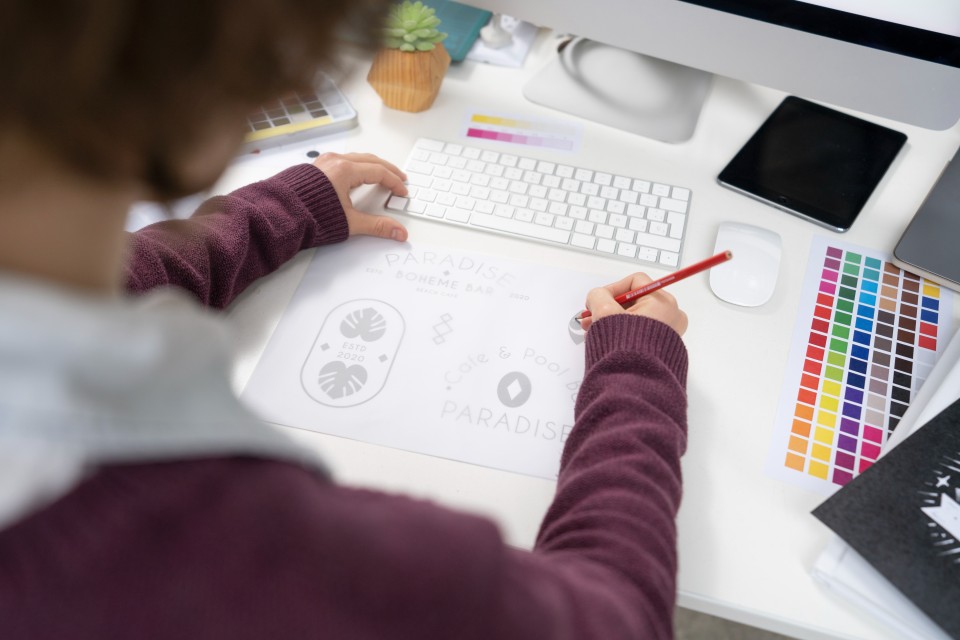
To-day AI technologies have been largely applied, in the same way, to a large number of industries including logo design. AI generated logos are prominent for their time-efficiency and low-cost but they also have certain flaws. Being aware of those boundaries is critical for companies that need to develop a recognisable and to-the-point brand identity.
Not being creative enough, nor the design, can disqualify AI-designed logos and this from catching the brand’s real personality and story. While AI is capable to provide multiple designing options, it might fail to render the emotional contact that a human can offer. AI Algorithms are even more dependent on template and trends which further does not mean the output will be unique and different.
The fact that AI-generated logos may not even show these brand values, mission, or target audience correctly is also important. In other instances, the brand’s symbol might be just wrongly understood or mistreated, thus resulting into mixed lines and lost opportunities. Achieving the brand consistency may be problematic with AI logos because they can resist the branding strategy.
Though AI is best in entertainment, it’s important to take into consideration its limitations when it comes to logo design. Thus, companies by realizing their limitations would be able to make balanced decisions that will depend on need of uniformity and distinction.
Limitations of AI-generated logos
As with any technology, AI-generated logos have their limitations. While they offer efficiency and convenience, they may fall short in capturing the essence of a brand and creating a unique and memorable identity. Understanding these limitations is essential for businesses aiming to create a logo that truly represents their values and connects with their target audience.
1. Lack of originality and uniqueness
One of the main limitations of AI-generated logos is the lack of originality and uniqueness. While AI algorithms can generate numerous designs, they often rely on pre-existing templates and popular trends. As a result, many AI-generated logos end up looking generic and fail to make a lasting impression.
A logo is the visual representation of a brand’s identity, and it should be distinctive and memorable. However, AI algorithms may struggle to deliver the level of creativity and uniqueness that human designers can offer. Human designers bring a level of intuition, experience, and artistic flair that AI algorithms have yet to replicate.
2. Limited customization options
Another limitation of AI-generated logos is the limited customization options available. While AI algorithms can generate a variety of designs, they may not allow for fine-tuning and customization to match a brand’s specific requirements. This can be particularly problematic for businesses that have specific design elements or color schemes they want to incorporate into their logo.
Customization is crucial for creating a logo that accurately represents a brand’s values, mission, and target audience. It allows businesses to create a logo that aligns with their brand strategy and stands out from competitors. However, AI-generated logos may not provide the level of customization needed to achieve these objectives.
3. Inability to capture brand essence and values
AI algorithms are programmed to analyze data and generate designs based on predefined parameters. While this can be useful for creating visually appealing logos, it may fall short in capturing the brand essence and values. A logo should reflect the personality, story, and values of a brand, and AI algorithms may struggle to achieve this level of understanding.
Creating a meaningful and impactful logo requires a deep understanding of a brand’s identity and its target audience. It involves interpreting the brand’s values, mission, and vision and translating them into a visual representation. This level of understanding and creativity is challenging for AI algorithms to replicate.
4. Potential copyright infringement issues
AI-generated logos may also pose potential copyright infringement issues. AI algorithms analyze vast amounts of data and existing designs to generate new ones. While this can be beneficial for inspiration and generating ideas, it also raises the risk of inadvertently creating a logo that infringes on someone else’s copyright.
Using copyrighted elements in a logo can lead to legal consequences and damage a brand’s reputation. Human designers are trained in copyright laws and understand the importance of creating original designs. They can ensure that a logo is unique and does not violate any intellectual property rights.
5. Difficulty in creating complex and intricate designs
AI algorithms excel at generating simple and straightforward designs. However, when it comes to creating complex and intricate designs, they may struggle to deliver the desired results. Complex logos often require a high level of creativity, attention to detail, and artistic skills that AI algorithms have yet to master.
Businesses that require complex logos, such as those in the creative industry or luxury brands, may find AI-generated logos inadequate. These logos may lack the finesse and craftsmanship that human designers can provide, resulting in a subpar representation of the brand.
While AI-generated logos have their limitations, it is important to acknowledge the value of human touch in logo design.
Importance of human touch in logo design
While AI technology offers speed and convenience, it cannot replace the human touch in logo design. Human designers bring a level of creativity, intuition, and understanding that AI algorithms have yet to replicate. Incorporating human creativity into the logo design process can result in a more meaningful and impactful logo that accurately represents a brand’s identity.
1. Emotional connection and storytelling
One of the key advantages of human designers is their ability to create an emotional connection and tell a story through a logo. A well-designed logo can evoke emotions, create a sense of trust, and communicate a brand’s values and mission. Human designers understand the power of visual storytelling and can create logos that connect with the target audience on a deeper level.
2. Customization and flexibility
Human designers also offer a high level of customization and flexibility when it comes to logo design. They can fine-tune every aspect of a logo to match a brand’s specific requirements and design preferences. This level of customization ensures that the logo accurately represents the brand’s unique personality and stands out from competitors.
3. Attention to detail and craftsmanship
Craftsmanship and attention to detail are essential in creating a visually appealing logo. Human designers have an eye for detail and can meticulously refine every element of a logo to ensure its visual harmony. They understand the importance of color psychology, typography, and composition, and how these elements contribute to the overall impact of a logo.
4. Brand consistency and strategy
Creating a logo is not just about the visual aesthetics; it is also about aligning with the overall brand strategy and maintaining brand consistency. Human designers can ensure that a logo fits seamlessly into a brand’s visual identity and effectively communicates its values, mission, and target audience. They take into account the brand’s positioning, target market, and long-term goals when designing a logo.
While AI-generated logos offer convenience and efficiency, it is important to strike the right balance between AI and human creativity in logo design.
Conclusion
There is no doubt that AI technology is constantly bringing forth newer and better versions in the domain of logo design with its speed, efficiency and great design collections. But at the same time, it must be underlined that AI is not a panacea and that human creativity also plays a role that cannot be substituted.
AI algorithms may generate logos effectively, but they may seem too unoriginal, lack options required for personalization, or be simply unable to depict a brand and its line. They may also be limited to certain copyright infringement options and find it difficult to build their own things that are complex and elaborate. While AI designers offer speed, efficiency, constant updates, data analysis, and uniformity, human designers provide emotional bonding, storytelling, customization, attention to details, craftsmanship as well as consistency of the brand.
The process of creating company logos is as important as balancing AI and human creativity. Drawing on the streamlined operations and ease of use of AI technologies, businesses can create both the first concept and a wide range of options. On the one hand, it is possible to use computer algorithms in logo creation. On the other side, introducing human designers in the process means that the final logo will exhibit the brand’s identity, will matter to the public and will become recognizable in a highly competitive market.
Finale, a logo is not simply an image but a brand persona. An emblem created by investing in human creativity and cognizance could be one that describes the brand in the deepest manner, long-lasting effects and contributes to success of the brand.
EmergingFreelancer is a custom logo creation platform, helping you to tell a visual story about your brand. Our team consists of highly skilled designers who work with clients to identify their mission, values and target audience and accordingly create logos that are not just a representation of their businesses but also of what they believe in. By focusing on creativity, innovation, and perfectionism in the design of a logo, we are able to provide exceptional product which stays long in the memory of the customers and puts them ahead of the competition. Call on EmergingFreelancer.com to output a one-off, unique, and memorable logo design to bring out your identity.
